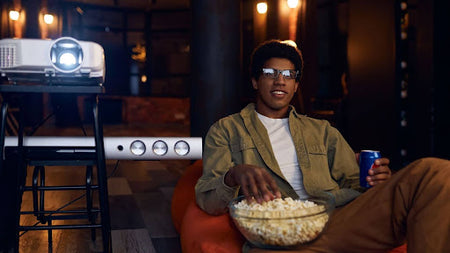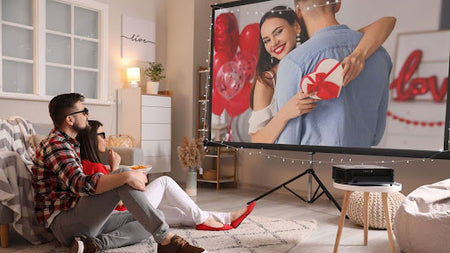Watching movies, shows, sports, and gaming has taken a fresh turn with the rise of home theater projectors. More folks are tuning into the big-screen magic they spin in their living rooms, chasing that immersive, cinema-like vibe. And it's not just about size – the image quality of projectors is getting sharper by the minute, making them a hot pick for budget-savvy cinephiles. So, if you're ready to supersize your viewing without supersizing your spend, let's explore how to pick the best budget projector for your home theater dreams.
Is A Home Theater Projector Better Than a TV?
Deciding between a home theater projector and a TV can be like choosing between a sports car and an SUV – both have their perks, but it really depends on what you're looking for.
- Size and Space: A projector wins the size game. It can give you a massive screen, much larger than most TVs, perfect for that cinema feel at home. But remember, you need a big, blank wall and a dark room for the best experience.
- Picture Quality: TVs, especially those fancy OLED ones, often outshine projectors in picture quality. They offer deeper blacks and more vibrant colors. So, if you're a stickler for crisp, rich images, a TV might be your go-to.
- Cost: Big screen TVs can be pricey, but projectors aren't always a budget option either. If you're thinking of going really big, though, a projector could give you more inches per dollar.
- Convenience: TVs are simpler. Just plug in and play. Projectors need a bit more setup, like adjusting the screen and managing the room light.
- Longevity: TVs generally last longer without needing much maintenance, while projectors might need a bulb change now and then.
In the end, it's about what fits your space, budget, and viewing preferences. Love movie nights in a dark room with a giant screen? Go projector. Prefer bright, sharp images for your shows and games? Stick to a TV.
How to Choose a Budget Home Theater Projector
When selecting the best budget home theater projector, consider the following factors during your purchase.
- Budget
When choosing the right projector on a budget, it's essential to find a balance between cost and quality.
Projectors like the WEWATCH V10 are growing popular for their affordability and features. Priced at $139.99, the V10 is compact and lightweight. It’s easy to set up in various spaces.
Offering a 1280x720 resolution and supporting 1080P, the V10 ensures clear and crisp images. The screen size can range from 40 to 260 inches, catering to different viewing preferences. The V10 is also equipped with 2.4G WiFi and Bluetooth 5.0. It’s also compatible with iOS, Android, and Windows devices. And with built-in HDMI 1.4, VGA, USB 2.0, TF card, AV, and a 3.5mm headphone plug, it's adaptable to various media sources, including TV sticks.
- Standard-Throw vs Ultra-Short-Throw
Space is key when picking a projector. Think about how much room you have between the projector and the screen. A standard-throw projector usually needs about 9 feet of space to work its magic. But if you're short on space, an ultra-short-throw projector is your friend – it only needs a few inches to display your content. These compact wonders are great for tight spots and offer more placement flexibility. However, remember that convenience comes at a cost, as ultra-short-throw projectors are generally pricier.
- Lamp vs. Laser Light Source
Projectors light up your content using either a lamp or a laser. Lamps, which include a bulb, tend to fade after 2,000 to 3,000 hours of use. This lifespan might be enough for casual users who only fire up their projectors occasionally. On the flip side, lasers boast a much longer life. Laser often lasts hours, which makes them a better fit for heavy use.
LED technology is another popular light source. These are known for being energy efficient and having a longer lifespan. These projectors can typically last up to 20,000 hours or more. Therefore reducing the need for frequent replacements.
WeWatch projectors all use LED technology. This choice reflects a commitment to offering projectors that are not only energy-efficient and long-lasting but also compact and convenient for a variety of settings.
- Picture Brightness
Picture brightness is another crucial factor to consider. Brightness level determines how well the projector can display images in various lighting conditions. In darker rooms, lower brightness might be sufficient. However, in well-lit rooms or spaces with a lot of natural light, a projector with higher brightness is essential to ensure clear and visible images.
Enter the WeWatch V51 Pro projector, which boasts 400 ANSI lumens. This brightness level means that it can stand up to environments with ambient light much better than many budget projectors, ensuring that movies and games pop off the screen with clarity and vivid colors.

- Resolution
Resolution determines the clarity and detail of the displayed image. The higher the resolution, the sharper and more defined the picture is. This is where the 1920x1080P resolution projectors shine.
WeWatch's range of projectors, including the V10 Pro, V50G, V51P, V53PRO, V70, and S1, all feature this 1920x1080P resolution. The V10 Pro, for instance, not only provides native 1080P resolution but also impresses with a 280-inch big-size screen capability. The V50G offers a similar resolution, adding 230 ANSI lumens of brightness and a 15,000:1 contrast ratio. This ensures vivid details and sharpness even in well-lit rooms.
The V51P stands out with its 400 ANSI lumens, which offers considerable brightness for a budget projector. It supports a massive screen size of 40"-300". The V53PRO, with 350 ANSI lumens and 4K support. It provides a dynamic range of visuals for various media content. The V70 Pro projector ups the game with 500 ANSI Lumen brightness and a dynamic contrast ratio of 15000:1.
Lastly, the WeWatch S1, with its native 1080p resolution, 360 ANSI lumens, and smart OS for convenient streaming. This is a versatile option for those looking for a blend of performance and convenience.
- Imaging Technology
Imaging technology in home theater projectors determines how the light is controlled to create the image. The three main types of imaging chips are DLP (Digital Light Processing), LCD (Liquid Crystal Display), and LCoS (Liquid Crystal on Silicon). Each type has its strengths: LCoS offers a great contrast ratio and is well-suited for cinematic experiences. LCD is typically the most cost-effective option. DLP is known for delivering the sharpest picture. However, it's important not to let the chip technology be the sole deciding factor in choosing a projector, as other aspects like brightness, resolution, and connectivity also play crucial roles
- Extra Features: Video and Sound Enhancements
Extra features like video and sound enhancements can significantly improve your viewing experience. High Dynamic Range (HDR) boosts the image quality, offering a brighter picture with dynamic contrasts. This works especially well with projectors that have high-brightness capabilities.
For audio, Dolby Atmos provides an immersive experience. Some projectors have Atmos speakers built-in, while others support HDMI eARC ports to pass high-quality audio, including Atmos, to your surround sound system. To fully benefit from these enhancements, ensuring that your other hardware and the content you're watching support these technologies is essential.
- Connectivity
Whatever projector you decide to get, you should ensure that it has solid connection support so that you can do things like plug in a Blu-Ray player or a PlayStation 5 system. Our V53PRO offers a full connection with a built-in HDMI, Bluetooth connection and 3.5mm headphone plug.
How Long Does a Smart Home Theater Projector Last?

The lifespan of a smart home theater projector primarily depends on the type of bulb it uses. Standard projector lamps, often metal arc or metal halide lamps, usually last between 1,000 to over 5,000 hours. LED bulbs, known for their efficiency, have a much longer lifespan, sometimes up to 60,000 hours, but are typically not replaceable by consumers. Laser bulbs last around 20,000 hours. Like LED bulbs, cannot be replaced by the user. Beyond the bulb type, factors like regular care and the environment in which the projector is used also influence its longevity
Conclusion
From ensuring crisp images with the right resolution to choosing the perfect brightness for your space, a budget-friendly projector is a gateway to cinematic bliss. Ready to upgrade your home theater? Dive into the diverse range of WeWatch projectors, where quality meets affordability.



